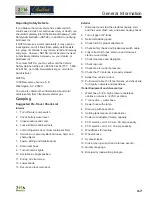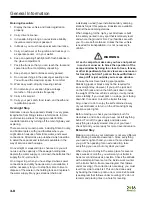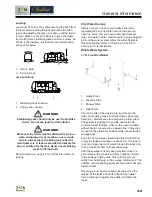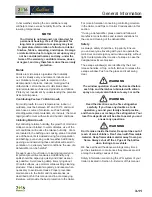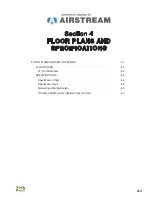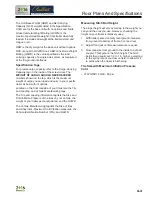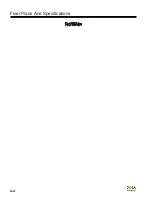
General Information
3-10
Things Not To Put Into Toilet Or Drains
• Facial tissues (they do not dissolve like toilet paper)
• Automotive antifreeze, ammonia, alcohols, or
acetone
• Table scraps or other solids that may clog the drains
Winter Traveling
Traveling in sub-freezing temperatures will require
certain precautions to protect the plumbing system
and your personal belongings from being damaged by
freezing
Whenever possible, the heat should be kept set to a
constant temperature It is easier for the furnace to
keep a constant room temperature than allow the trailer
temperature to drop to 50°F, and then attempt to raise it
to room temperature
NOTE
The trailer has been equipped with air conditioners
with heat pumps and should not be used if ambient
temperatures remain below 25°F for more than 12
hours.
NOTE
Drain and winterize all models if the water systems
are not being used during winter traveling. Refer
to Section 8 - Maintenance in this manual for
winterizing instructions.
Some states do not allow LPG to be turned on while
moving While traveling in these states, simply use
your common sense How cold is it? How long will
it be before you can turn the heat back on? Is the
temperature dropping or rising? Remember, when
towing at 50 MPH, the wind chill factor will cause the
interior of the trailer to cool much faster than a trailer
that is parked
When parked in sub-freezing temperatures, make sure
to keep a full supply of LPG and plug into a 110-volt
power source whenever possible A fully charged
battery will not last more than 8 to 10 hours if the
furnace is running almost constantly and 110-volt power
is not available
Leave cabinet doors, wardrobes, and bed doors partially
open to allow warm air to circulate around plumbing
lines and fixtures. Insulate and/or wrap your exterior
water lines with heat tape
Effects Of Prolonged Occupancy
Your trailer was designed primarily for recreational use
and short-term occupancy If you expect to occupy the
trailer for an extended period, be prepared to deal with
condensation and the humid conditions that may be
encountered
Moisture can condense on the inside surfaces of the
trailer during cold weather when relative humidity
of the interior air is high This condition is increased
because the insulated walls of a recreation vehicle
are much thinner than house walls Also, the relatively
small volume and tight, compact construction of
modern recreational vehicles means the normal living
activities of even a few occupants will lead to rapid
moisture saturation Estimates indicate a family of four
can vaporize up to 3 gallons of water daily through
breathing, cooking, bathing, and washing Unless
the water vapor is carried outside by ventilation or
condensed by a dehumidifier, it will condense on the
inside of the windows and walls as moisture, or in
cold weather, as frost or ice It may also condense
out of sight, within the walls or the ceiling, where it will
manifest itself as warped or stained panels
Appearance of these conditions may indicate a serious
problem When you recognize the signs of excessive
moisture and condensation in the trailer, action should
be taken to minimize their effects
Tips To Control Condensation
Allow excess moisture to escape to the outside when:
• Bathing, washing dishes, hair drying, etc
• Laundering, using appliances, and using non-vented
gas burners
• Cooking (Always use the stove vent hood)
Avoid dead air spaces by:
• Using a fan to keep air circulating
• Leaving closet and cabinet doors partially open
To help alleviate cold weather condensation:
• Keep the temperature as reasonably cool during cold
weather as possible
• Allow your trailer to breathe; do not make it airtight
• Allow some warm air to be removed and some cool
outside air in
• Do not allow the furnace to recycle humid interior air;
provide reasonable ventilation
Summary of Contents for Pendleton
Page 6: ...1 2 Introduction NOTES ...
Page 24: ...NOTES 3 12 General Information ...
Page 28: ...Floor Plans And Specifications 4 4 NOTES ...
Page 38: ...5 10 Interior Lavatory Faucet Replacement Parts ...
Page 60: ...NOTES 6 10 Exterior ...
Page 68: ...Towing 7 8 NOTES ...
Page 86: ...Maintenance 8 18 Electrical Diagrams 12 Volt Diagrams ...
Page 94: ...NOTES 8 26 Maintenance ...
Page 97: ......












